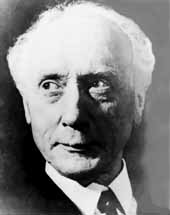
What is the Alexander
Teachnique?
"Every man, woman and child holds
the possibility of physical perfection; it
rests with each one of us to attain it by
personal understanding and effort."
F.M. Alexander
 |
What is the Alexander |
The Technique was developed in the late 19th century by F.M. Alexander,
a Shakespearean orator. Having lost his voice, Alexander undertook an
intensive program of self-observation that lasted for nearly a decade in order
to discover the source of his problem. In the process, he not only regained his
voice, but also laid the foundation for the Alexander Technique.
Alexander practiced the Technique in England and the U.S. until his death
in 1955. Among his students were John Dewey, Aldous Huxley, George
Bernard Shaw, and Nikolaas Tinbergen (who gave part of his 1973 Nobel
prize speech on the Technique).
How Does It Work?
A typical Alexander lesson is divided principally into two activities--
"chair work" and "table work."
Chair Work
The Technique uses the action of repeatedly sitting in a chair and then
standing as a way to gain awareness of and eventually correct movement
and postural habits. Since sitting and standing are among our most frequent
activities, they serve as the foundation of the Technique.
During this portion of the lesson, the teacher generally guides the student
in and out of the chair, providing the student with the experience of movement
which is effortless and tension-free. Together, the teacher and student learn
to stop or, as Alexander called it, "inhibit," habitual responses to the stimulus
of either sitting or standing. By stopping for a moment before the action takes
place, the teacher and student have time to use reasoning powers to asses
which is the most efficient and appropriate way to perform the action
of either sitting or standing.
Chair work allows students to learn what it is they do when moving. Special
attention is paid to the relationship between the head, neck and the rest of the
back, the relationship which Alexander noticed as primary in the performance
of all movements.
Alexander spoke of chair work as follows:
Boiled down, it all comes to inhibiting a particular reaction
to a given stimulus—but no one will see it that way. They
will see it as getting in and out of a chair the right way. It is
nothing of the kind. It is that a pupil decides what he will,
or will not, consent to.
Chair work is thus the basis for the students learning how s/he moves
in any activity. Once awareness is gained in this single activity, the
student acquires the power to control all reflexes in order to direct the body—
the self—in a coordinated and balanced way.
Table Work
The other part of a lesson involves "table work." Students lie on their backs
with feet flat and knees bent in what is know as the semi-supine position, or
the rest position. The teacher is encouraged to inhibit tension and remain alert.
It is during this part of the lesson that the student becomes quiet to the external
world so that s/he may give full attention to the self.
Table work is an effective complement to chair work since gravity has less
influence on body movement and habits. It is a time when students may reflect
upon their habitual patterns of movement but without the active demands
of movement.
Why Are Sessions Called
Lessons?
The Alexander Technique, unlike other "body work", emphasizes learning. It
does not attempt to "fix" a particular problem but rather to re-educate. Its focus
is not on the particular but rather on the whole movement. The Technique encourages
an experiential way of learning—including intuitive, sensory, and other non-cerebral
ways of acquiring knowledge—so as to master new skills in the art of movement.
What Are The Benefits?
The Technique gives the individual an improved sense of well-being.
Students enjoy:
- Increased relaxation and coordination
- Ease of movement
- Heightened muscle strength
- Increased flexibility
- Enhanced equilibrium
- Decreased physical tension
- Reduced stress
- Improved sensory awareness
The rewards can be deep and far-reaching. Students often achieve greater control
over themselves and the events in their daily lives. They cultivate an increase
in powers of observation and develop a much sharper sense of awareness.
How Long Does It Take
As with the learning of any skill, such as the learning of a musical instrument,
the process demands commitment on the parts of both teacher and student.
Alexander prescribed a minimum course of 30 lessons, a period he thought
necessary to acquire the basic principles of the Technique. The length of time
necessary, though, depends greatly on how much misuse the body has already
received and how severe the problems are before the lessons begin.
Lessons last approximately 30 - 45 minutes and are conducted on a one-
to-one basis.
Who Can Benefit From The Alexander
Technique?
Those who can benefit from the Alexander Technique include individuals seeking
lasting relief from any of the following physical problems:
|
|
Who Else Can Benefit?
Others who can greatly benefit from the Alexander Technique include:
People whose occupations can cause poor postural habits such as:
- dentists
- carpenters
- computer operators
People who must use their bodies with maximum efficiency such as:
- musicians
- dancers
- singers
- actors
- golfers
- tennis players
- weightlifters
People who are experiencing new aches and pains due to:
- pregnancy
- aging
- accidents